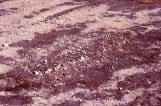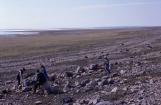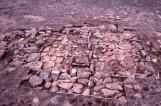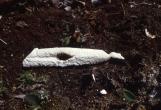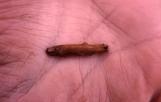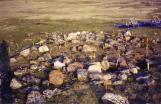15
This picture of the Cadfael site was taken from the air above Iqaluktuuq. It shows a very large longhouse that stretched 38m (120 feet) along the ground and was built in the late Dorset period (800AD to 1250AD). The usage of the longhouse is believed to be similar to the longhouse at the Ekvana site, which was mainly used by people who hunted and gathered during the summer, for sharing information, trading, or for ritual gatherings.Photo by M. Friesen.
17
This is another longhouse at the Cadfael site that was built during the late Dorset period. This house, constructed of large rocks and boulders, was measured at 19m long.Photo by M. Friesen.
19
This is a Dorset house excavated at the Ekvana site situated near Cambridge Bay. The two rows of neatly placed stone slabs at the centre of the house are called the 'axial feature' or 'midpassage'.Axial features are found in many Dorset houses, and are often built with small boulders of vertically placed stone slabs. The axial feature was believed to have been used as a hearth (fireplace) and storage or work area.
Photo by M. Friesen.
21
The Dorset people often expressed their ideology through art; therefore, Dorset carvings provide crucial information about Dorset belief systems to archaeologists. Although their precise meaning is not fully understood, many carvings may have functioned as amulets.This picture was taken at the Bell site and it shows a wooden carving of a human face. Although its meaning has not yet been deciphered by modern archaeologists, it obviously held deep importance to its Dorset creator.
Photo by M. Friesen.
23
A late Dorset harpoon head is shown in the picture. The tip of the harpoon head has been carved into the shape of a king eider duck. Perhaps this was intended to give the harpoon head the ability to fly swiftly.Photo by M. Friesen.
25
This is another example of a Dorset carving. This carving of an arctic char was recovered at the Bell site during the 2004 field season. Carvings of fish are quite rare in Dorset culture, and it is probably no coincidence that this one was found at a very important fishing location.Photo by M. Friesen.
27
The Second wave of immigrants, known as the Thule culture, came into the Eastern Arctic about 1000 years ago, and probably arrived at Iqaluktuuq around 1250 A.D. Their descendants are today's Inuit. Thule people in other regions hunted bowhead whales with their boats (qajaq and umiak), as well as specialized hunting tools such as large harpoons & inflated skin floats for tiring and retrieving the animals.There is no doubt that Thule technologies were more complex and sophisticated than those of Tuniit (Dorset) people. They developed more sophisticated harpoon heads for more successful sea-mammals hunting, dog sleds were introduced, they polished slate tools such as the ulu (woman's knife), and made large soapstone pots & lamps. The bow and arrow was re-introduced by the Thule Inuit after it was mysteriously abandoned by the Dorset People.
The Bell Site contains several Thule houses, including this one excavated at the Bell site in summer 2004 by Dr. Max Friesen, by the Iqaluk river.
This excavation began with the setting up of a grid system, allowing for precise mapping of each artifact found. The grid lines are indicated by the yellow pegs in the picture.
Photo by W. Kok.
